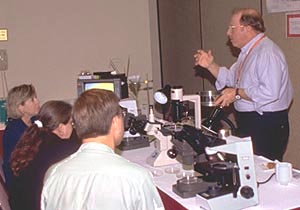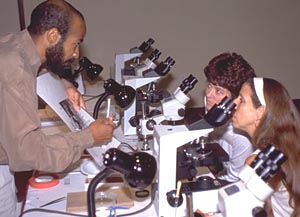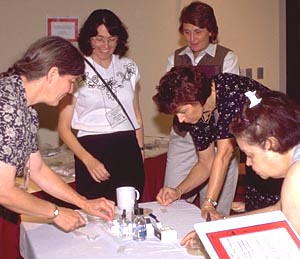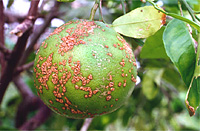By Kisha Shelton,
Plant Pathology Department, University of Georgia
On Monday, August 14 in New Orleans, Louisiana, sixteen middle and high school teachers became students as they participated in the workshop entitled Plant Pathology for Middle and High School Biology Teachers. The workshop was sponsored by The American Phytopathological Society Youth Programs Committee, Teaching Committee, and the Office of Public Affairs and Education. Teachers came from surrounding areas of Louisiana and Arkansas, with one teacher traveling from New York.
Teachers were welcomed by Gail Ruhl, Purdue University and Tom Evans, University of Delaware. After a brief introduction teachers were treated to presentations by Clayton Hollier, Louisiana State University, on "Plant Pathogens: Useful tools in teaching biological sciences" and Edward C. McGawley, Louisiana State University, on "Nematodes: Worm your way into your student's hearts".
 |
| Edward C. McGawley |
Teachers were divided into small groups in order to rotate among the many displays. Clayton Hollier provided a table filled with diseased plant specimens. Teachers had the opportunity to look through plants exhibiting different types of symptoms and ask questions regarding the cause of the disease and where they might find specimens for their classes. Edward C. McGawley added to his earlier presentation about "Nematodes: Worm your way into your student's hearts" with a table display on nematodes. Stereo microscopes were provided by the Louisiana State University Department of Plant Pathology and Crop Physiology and compound microscopes were provided by Olympus. Teachers were able to observe nematodes using the microscopes. The second nematode exhibit was provided by Joseph Esnard, Cornell University. Joseph provided the teachers with an opportunity to observe the life stages of a root-knot nematode.
 |
| Joseph Esnard |
Gail Schumann, University of Massachusetts, had two demonstrations on her display table. Schumann instructed the workshop participants on how to do "Gram stain without the mess." Using a 3% potassium hydroxide solution and a plate of gram negative bacteria, she demonstrated that DNA could be strung up on a toothpick in just seconds. While they were visiting her display, teachers also had the opportunity to learn about Oomycetes, or "water molds ". Schumann showed the teachers how to use popcorn to bait Oomycetes in stream water for observation by the students. Ruhl provided an opportunity for teachers to learn about differentiating between the different types of powdery mildew. Using the microscopes, they were able to observe the cleistothecia of different powdery mildews. Albert K. Culbreath, University of Georgia, provided the teachers a web-based lesson. Culbreath demonstrated "A web-based tool for risk assessment of potential tomato spotted wilt virus (TSWV) infections in peanuts" to the instructors. Teachers can now make use of the TSWV Risk Index to show their students some of the science behind agriculture.
 |
| Gail Schumann |
Tom Evans and R. B. Carroll, University of Delaware, provided a display entitled "Koch's postulates: What causes disease." Teachers had the opportunity to observe how to determine if an organism is causing a disease but also what a soft-rot bacterium can do to carrots. Another web-based display was provided by C. J. D'Arcy and D. M. Eastburn, University of Illinois. They demonstrated "Dutch Elm disease: An interactive lesson" to the teachers. Each teacher had a chance to go through different parts of the interactive lesson to learn how Dutch elm disease moves and how the disease can be controlled.
Teachers attending the workshop were provided with a 2000 Teacher's Guide to Plant Pathology (a manual for the workshop). The manual contained all the experiments and lesson plans for all the demonstrations at the workshop. Teachers also received a copy of the book "Learning Biology with Plant Pathology" by Juliet E. Carroll. If you are looking for something new for your students you might consider becoming a student again at an American Phytopathological Society-sponsored workshop for teachers.
 |
Views: Recent outbreaks of citrus canker in lime groves in the Miami, Florida area have been reported by the news media. Although the disease is not a health threat to humans, it is of great concern to the citrus industry.Click here for more information.
|
